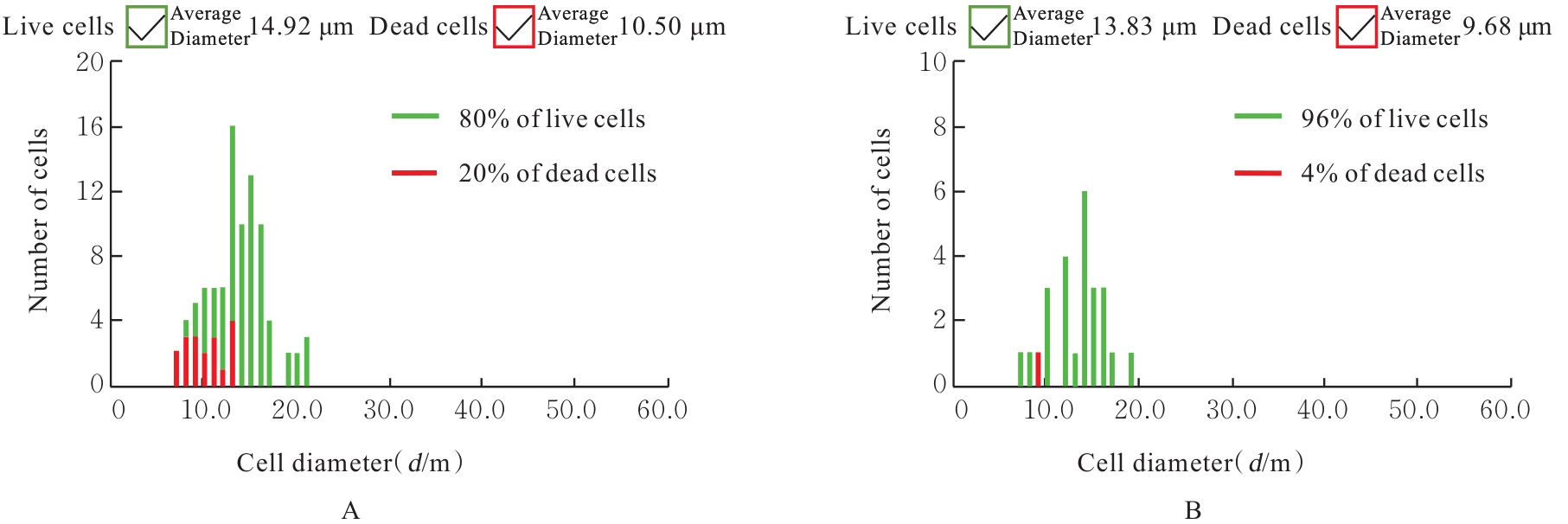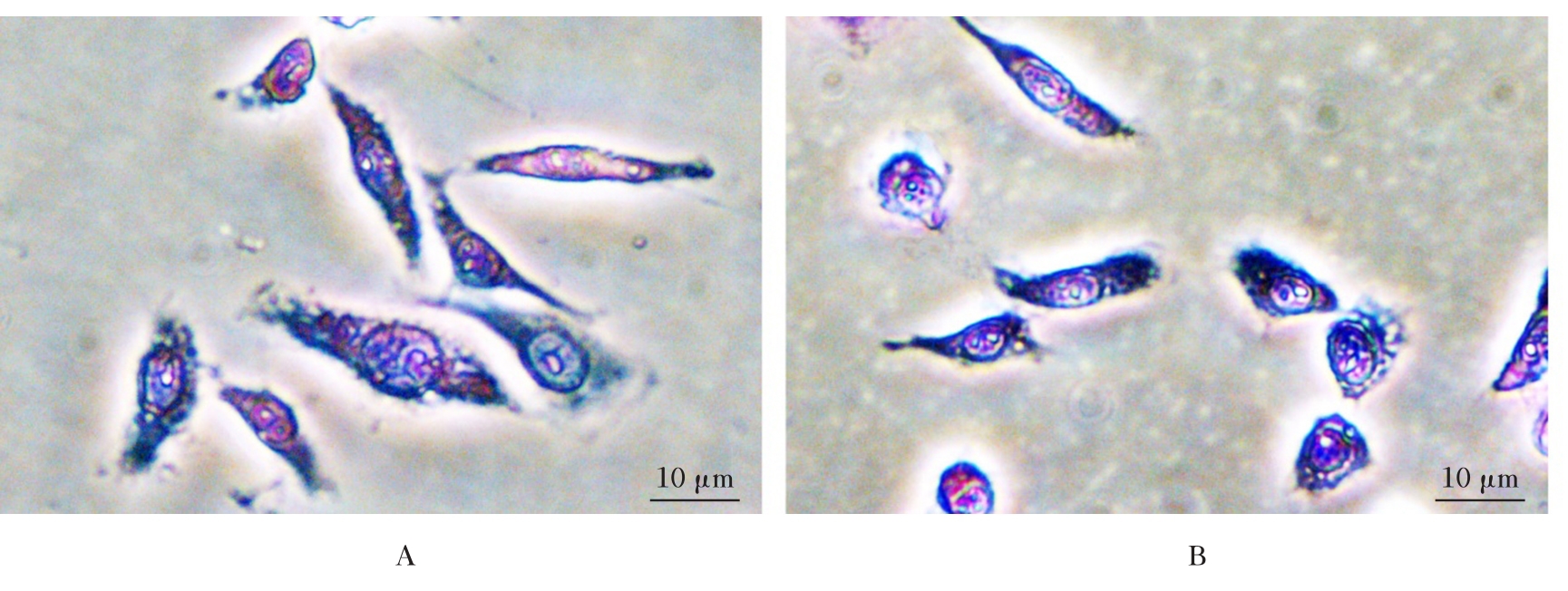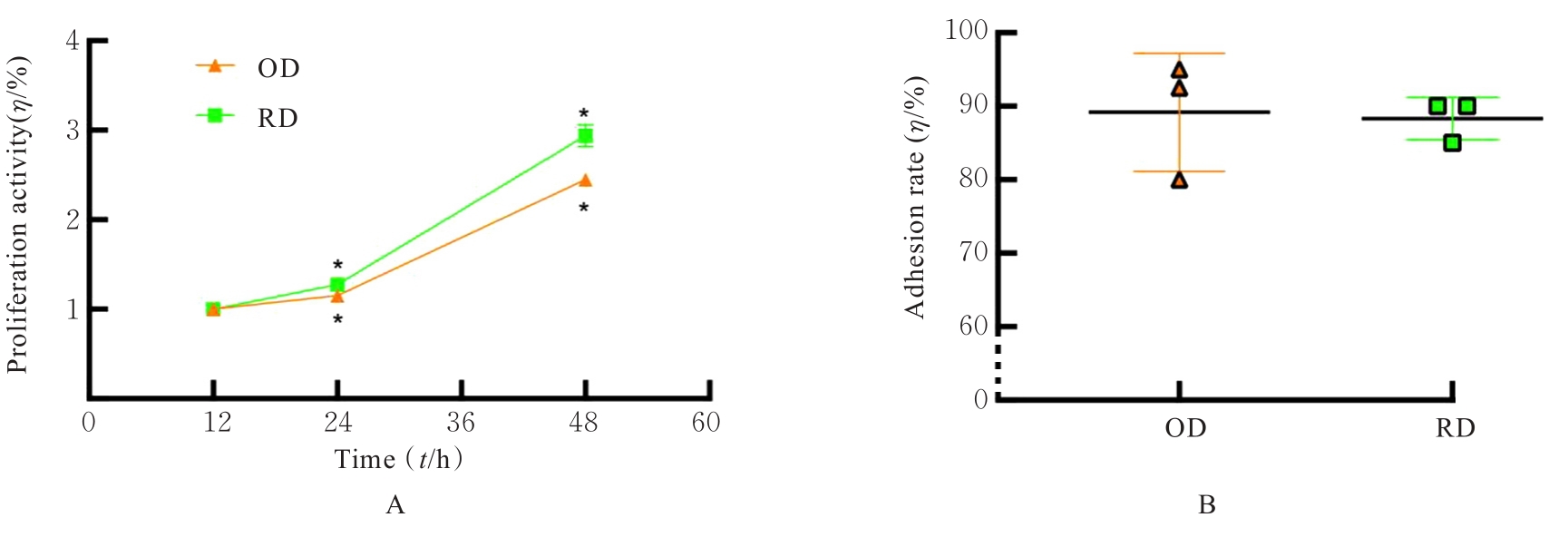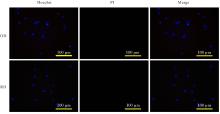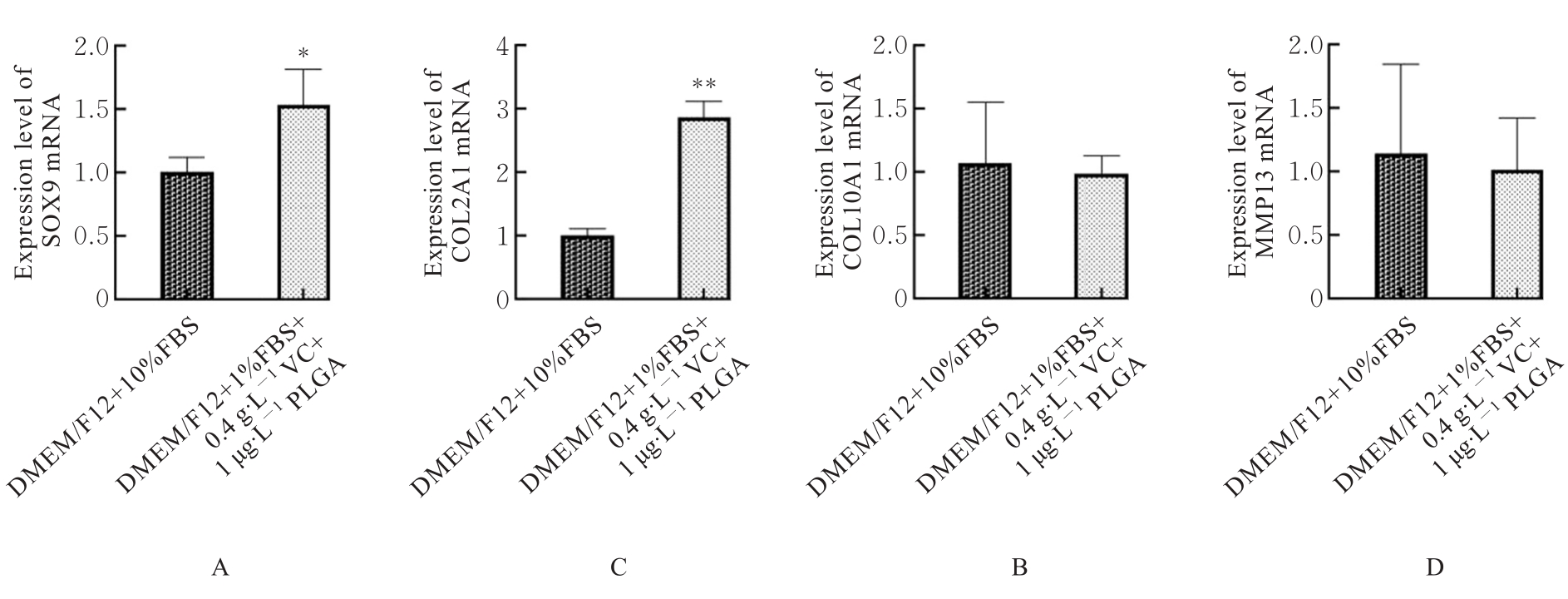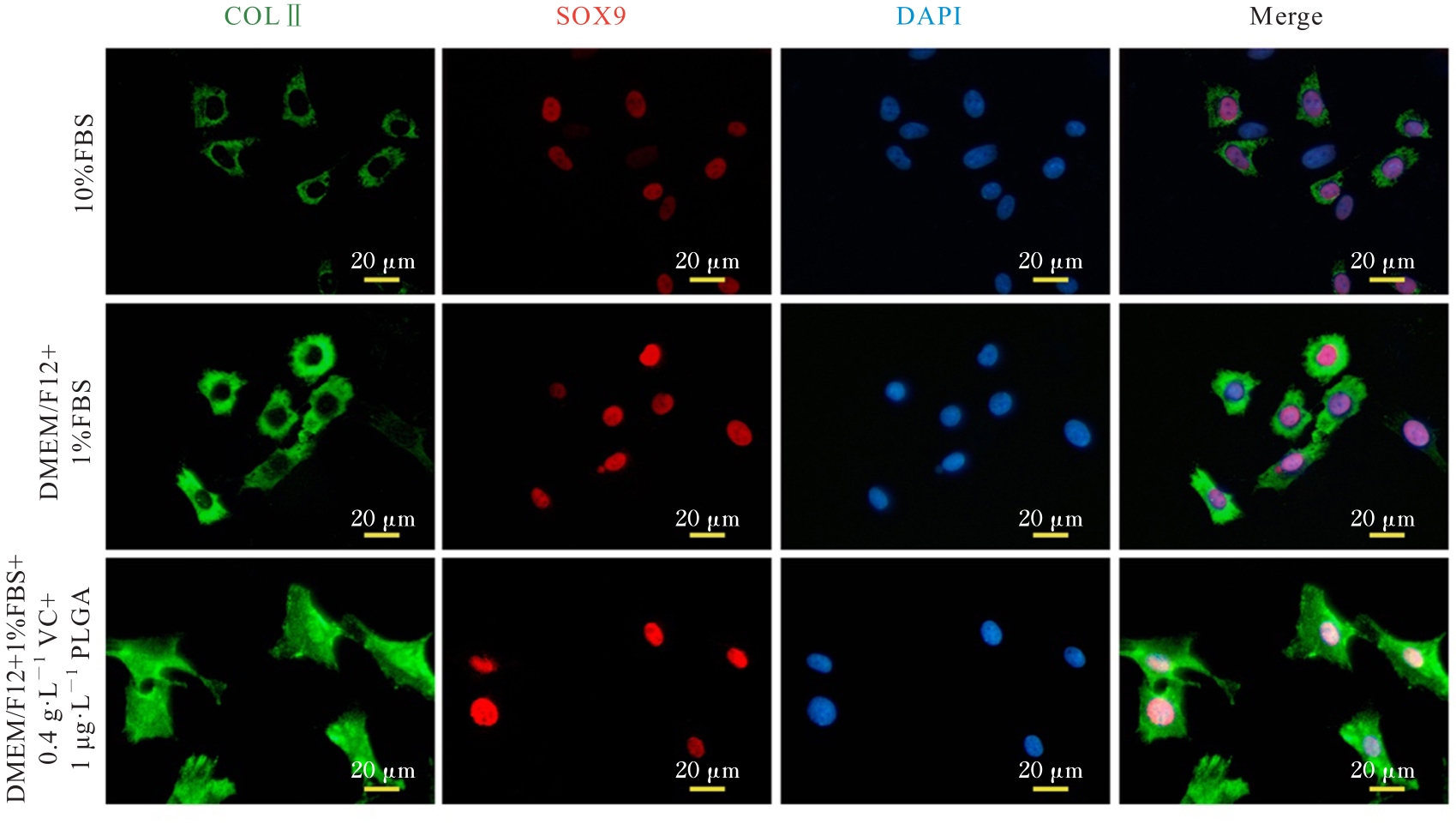吉林大学学报(医学版) ›› 2024, Vol. 50 ›› Issue (5): 1438-1449.doi: 10.13481/j.1671-587X.20240531
• 方法学 • 上一篇
新生大鼠原代软骨细胞分离和培养方法的改进
杨丹聃1,陈骄阳,王馨珩2,赵泽彤,潘莹3,薛百功3,高长曌4( )
)
- 1.吉林大学基础医学院病原免疫细胞遗传学实验中心,吉林 长春 130021
2.吉林大学中日联谊医院皮肤科,吉林 长春 130033
3.吉林大学基础医学院细胞学系,吉林 长春 130021
4.吉林大学中日联谊医院放疗科,吉林 长春 130033
Improvement of isolation and culture methods for primary chondrocytes of neonatal rats
Dandan YANG1,Jiaoyang CHEN,Xinheng WANG2,Zetong ZHAO,Ying PAN3,Baigong XUE3,Changzhao GAO4( )
)
- 1.Experimental Center of Pathogenobiology Immunology Cytobiology and Genetics,School of Basic Medical Sciences,Jilin University,Changchun 130021,China
2.Department of Dermatology,China-Japan Union Hospital,Jilin University,Changchun 130033,China
3.Department of Biology,School of Basic Medical Sciences,Jilin University,Changchun 130021,China
4.Department of Radiotherapy,China-Japan Union Hospital,Jilin University,Changchun 130033,China
摘要:
目的 探讨新生大鼠原代软骨细胞分离和培养的改进方法,以建立高效经济的体外软骨细胞培养体系。 方法 从新生大鼠关节中分离原代软骨细胞,分为过夜消化(OD)组和快速消化(RD)组进行分离,OD组软骨细胞采用Ⅱ 型胶原酶过夜消化,RD组软骨细胞采用预消化的物理化学消化相结合的手段分离细胞。采用含0%(空白组1)、1%、2%、4%和10%胎牛血清(FBS),0(空白组2)、0.1、0.2、0.4、0.8、1.0、2 .0 g·L-1维生素C(VC)和0(空白组3)、0.5、1.0、2.0、4.0、8.0、10.0 μg·L-1聚乳酸-羟基乙酸共聚体(PLGA)纳米粒子的改良培养液培养软骨细胞。将杜氏改良Eagle培养基F12营养混合液(DMEM/F12)与含不同浓度FBS、VC和PLGA的培养液分别混合,并按照各成分浓度进行相应分组。采用细胞计数仪计数各组细胞并检测各组细胞存活率和直径,采用甲苯胺蓝特异性染色法检测各组细胞形态表现,采用CCK-8法检测各组细胞增殖活性,采用细胞黏附实验检测各组细胞黏附率,采用Hoechst/碘化丙碇(PI)染色检测各组细胞凋亡情况,采用MTT法检测改良培养液培养后各组细胞增殖活性,将细胞分为DMEM/F12+10%FBS组(对照组)、DMEM/F12+1%FBS组、DMEM/F12+1%FBS+0.4 g·L-1 VC+1 μg·L-1 PLGA组,采用实时荧光定量PCR(RT-qPCR)法检测改良培养液培养后各组细胞中性别决定区域Y框转录因子9(SOX9)、Ⅱ型胶原α1链(Col2A1)、Ⅹ型胶原α1链(Col10A1)和基质金属蛋白酶13(MMP13)mRNA表达水平,采用免疫荧光染色检测改良培养液培养后各组细胞中Ⅱ型胶原(COLⅡ)和SOX9表达情况。 结果 OD组原代软骨细胞存活率小于RD组,细胞平均直径大于RD组。OD组原代软骨细胞形态较大,呈梭形,大多数细胞出现伪足;RD组原代软骨细胞形态较小,大多数细胞呈菱形,仅部分细胞出现伪足。2组原代软骨细胞经甲苯胺蓝特异性染色均显色明显,但RD组消化时间较短,软骨细胞实际培养时间较OD组缩短9~13 h,原代软骨细胞形态更为幼稚。OD组原代软骨细胞在培养24 h时增殖较为缓慢,培养48 h时增殖速度升高,较培养12 h时增殖活性明显升高(P<0.01)。RD组原代软骨细胞在培养24 h时增殖稍缓,培养48 h时增殖速度加快,较培养12 h时增殖活性明显升高(P<0.01);培养24和48 h时,与OD组比较,RD组原代细胞增殖速度升高(P<0.05)。RD组软骨凋亡细胞数少于OD组,2组均无坏死软骨细胞。大鼠软骨细胞增殖活性随着培养液中FBS浓度升高而升高,与空白组1比较,培养液中含1%、2%、4%和10%FBS时,软骨大鼠细胞增殖活性明显升高(P<0.05)。与空白组2比较,培养液中含0.2~1.0 g·L-1 VC时大鼠软骨细胞增殖活性明显升高(P<0.05),其中含0.4 g·L-1 VC时大鼠软骨细胞增殖活性最高(P<0.01)。与空白组3比较,培养液中含1~4 μg·L-1 PLGA时,大鼠软骨细胞增殖活性明显升高(P<0.05),其中含1 μg·L-1 PLGA时大鼠软骨细胞增殖活性最高(P<0.05)。与DMEM/F12+10%FBS组比较,DMEM/F12+1%FBS组大鼠软骨细胞中SOX9 mRNA和COL2A1 mRNA表达水平均明显升高(P<0.05或P<0.01)。与DMEM/F12+10%FBS组比较,DMEM/F12+1%FBS+0.4 g·L-1 VC+1 μg·L-1 PLGA组大鼠软骨细胞中SOX9 mRNA和COL2A1 mRNA表达水平明显升高(P<0.01)。免疫荧光染色,荧光显微镜下DMEM/F12+10%FBS组部分软骨细胞中出现COLⅡ绿色荧光信号和SOX9红色荧光信号,荧光强度弱;DMEM/F12+1%FBS组大多数软骨细胞中出现COLⅡ绿色荧光信号和SOX9红色荧光信号,荧光强度明显强于DMEM/F12+10%FBS组;DMEM/F12+1%FBS+0.4 g·L-1 VC+1 μg·L-1 PLGA组软骨细胞中均出现COLⅡ绿色荧光信号和SOX9红色荧光信号,荧光强度较DMEM/F12+10%FBS组和DMEM/F12+1%FBS组明显升高。DMEM/F12+1%FBS组软骨细胞中COLⅡ和SOX9蛋白表达量明显高于DMEM/F12+10% FBS组,DMEM/F12+1%FBS+0.4 g·L-1 VC+1 μg·L-1 PLGA组软骨细胞中COLⅡ和SOX9蛋白表达量明显高于DMEM/F12+10%FBS组。 结论 改良后的大鼠原代软骨细胞分离和培养方法可以弥补传统方法的缺陷,缩短原代软骨细胞的分离时间,提高原代软骨细胞的体外培养质量。
中图分类号:
- Q813.1

